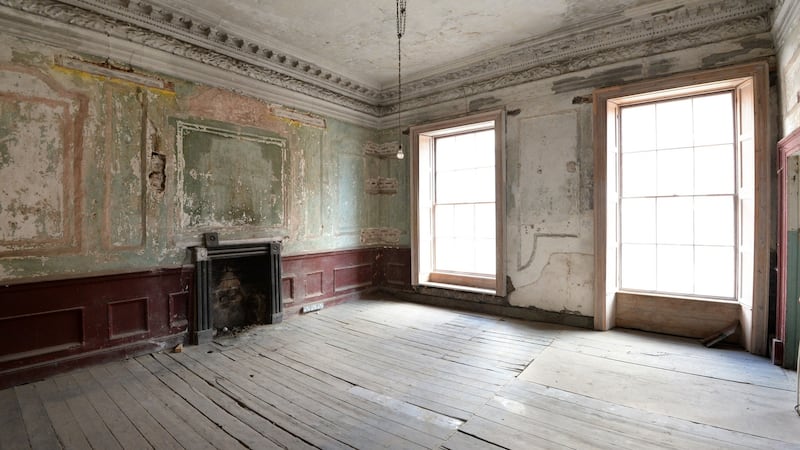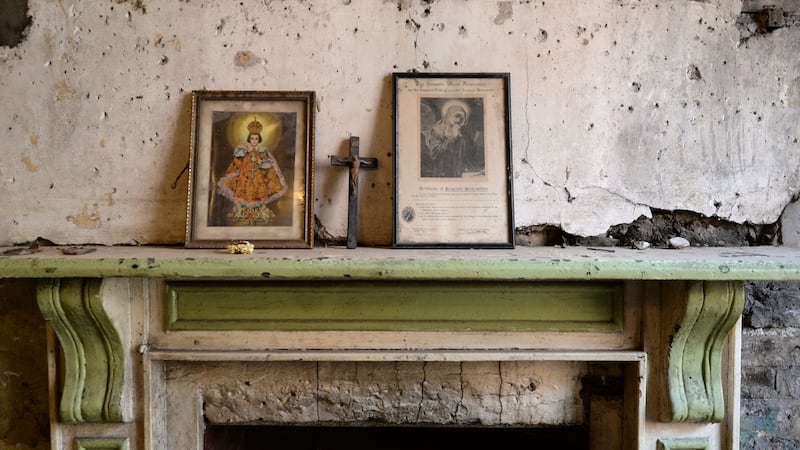The “distressed” look that was once quite fashionable is very much part of the character of Georgian houses on Henrietta Street in Dublin 1. This notably applies to number 14, which has been largely untouched for nearly a century and still reeks of tenement life in Dublin when it was “home” to more than 100 people.
Conservation architectural firm Shaffrey Associates describes it as “a rich palimpsest of the layers of occupation”. Particularly evocative, it says, is “the patina created by the traces of time and use, which varies from faint, but intact, early 19th-century stencilling to multiple layers of limewash in the rear stairwells.”
Owned for years by eccentric landlords Ivor and Marie Underwood who, bizarrely, kept it vacant, it was subsequently acquired by Dublin City Council. It secured the building's stability in 2009 so that it could be used for temporary events such as the Dublin Tenement Experience: Living the Lockout in 2013.


It became obvious then that number 14 Henrietta Street would be a great candidate for conversion in to a tenement museum to show what life was like in the city’s teeming slums. And despite the prevalence of tenements in once-grand Georgian houses, there was nowhere in Dublin offering such an experience.
Last May, the Department of Arts, Heritage and the Gaeltacht announced a grant of €1.5 million for a “tenement museum” at the house, which had been built in 1748 by north inner city developer Luke Gardiner; it was one of seven “flagship capital projects” planned to commemorate the centenary of the Easter Rising.
Since then, there has been a divergence of views between the department and the council over what exactly was intended. The council sees it as a “social history museum” that would show visitors “the contrasting experiences of daily life in the house . . . from the mid-18th century to the tenement period”.
Under the council’s plan, not only would the original grand staircase – ripped out in the late 19th century to make way for more flats – be reinstated, but only one room would be restored as a tenement flat from the 1960s, with some oral recordings of the memories of people who lived in tenements.
“We will showcase the architectural heritage and rich and varied social history of the house and the street from its 18th century Georgian beginnings to its transformation at the end of the 19th century as a street of tenements housing over 900 people,” according to a council statement on the project.
Original grandeur
Having been inhabited by members of the aristocracy and later the legal profession, number 14 was turned into a tenement in 1882. Rooms were divided by partitions to form “compact three-roomed flats” and, by the 1911 census, there were 17 families living in the building. One can barely imagine it.
Council heritage officer Charles Duggan said reinstating the grand staircase of what he calls the “14 Henrietta Street Townhouse Museum” was intended to give people a “sense of the original grandeur of the house”, which was built for the “ruling elite” long before it became home to the “urban poor”.
However, in January outgoing Minister of State Aodhán Ó Ríordáin saw this as “a concerted attempt to rebrand the tenement museum as the ‘townhouse museum’,” and insisted it must focus on “telling the story of tenement life, of the cramped conditions of poverty and disease, of the social history of that period in Dublin life”.
Allocating one room in a building that extends to some 1,000sq m (10,764sq ft) to be fitted out as a tenement flat hardly seems adequate. Only three of the five floors – basement, ground and first – will be open to the public, with the top two floors given over to office, education, storage and staff facilities.
To comply with universal access requirements, a new three-storey extension at the rear would incorporate a lift shaft and toilets. Alterations to the front steps and railings for wheelchair access are less defensible, as there will be a new pedestrian route via a gate through the rear garden wall.
The Department of Arts, Heritage and the Gaeltacht now says it is “working in partnership with Dublin City Council on the development of No 14 Henrietta Street as a centre for the exploration of Georgian and tenement life in North Inner City Dublin” and its Ireland 2016 project team is “monitoring progress” on the plan.
If Henrietta Street is to be re-established on people’s mental maps of Dublin, the department should also provide much-needed funding for Na Píobairí Uilleann next door to build an international visitor centre, designed by Ryan Kennihan. This would have the added benefit of filling in a long-vacant site.
The tenement/townhouse museum together with the pipers' €5 million project would serve as catalysts to transform the fortunes of Dublin's oldest and grandest Georgian street, which has been so down-at-heel for many decades that it has been used as a slum location for Strumpet City and various films.
Creating the proposed tenement/town- house museum, with “early 2017” now set as its opening date, would not only commemorate the city’s once notorious slums, but could signal a cultural renewal of Henrietta Street itself, with positive impacts on an area that has suffered serious neglect for years.












